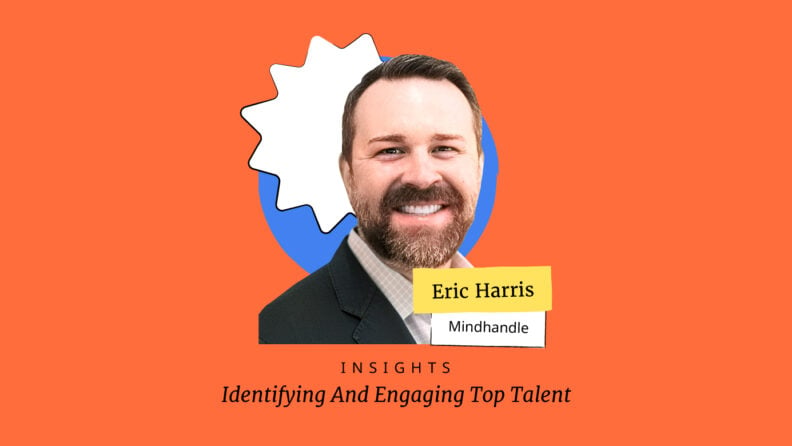Companies are always on the lookout for talented people. In this interview series, we talk to seasoned HR professionals to pick their brains for ideas and insights on finding the right talent for our organizations.
Hi Eric, welcome to the series! We’d love to get you to know you a little better, can you tell us the "backstory" about what brought you to this specific career path?
I’m a seasoned communications professional with experience in both marketing agency and corporate roles. After several years in large advertising agencies, I joined my clients on the corporate team at YUM! Brands, where I led Pizza Hut’s integrated communications for two years.
The experience taught me not only what it was like to be on the “buying” side of the agency economy, but also how much room there was to improve on internal communications. That’s why I founded GatherRound, a training company focused on storytelling for presentations.
In 2018, GatherRound and MindHandle merged, creating an employment branding agency with the talent and expertise to reach employees with advertising quality messages because I believe this deserves as much attention as advertising (if not more).
It has been said that our mistakes can be our greatest teachers. Can you share a story about the funniest mistake you made when you first started and what you learned from it?
Sometime in the early 2010s, when I was a young, enterprising creative director at a large ad agency, I had the opportunity to present to the head of HR at a massive organization.
It was my first time to present to this department, let alone this individual, and I was very intimidated by her presence. Armed with a great idea and a ton of confidence I hadn’t earned, I walked into her office with my team, believing I was ready to present, having not rehearsed for a single minute.
I fumbled through the up-front, and barely made it to the end, at which point she asked, “Which of these concepts do you recommend?”. What I tried to say was “We all have heart for this concept,” but I tripped on my words and what I actually said was something very offensive, which I won’t repeat here.
Fortunately, she gave me some grace and we had a good laugh about it, but I've never walked into another presentation without rehearsing with my team after that.
Can you give us your favorite "Life Lesson Quote" and how that was relevant to you in your life?
My parents used to tell me “If you want to be respected, be consistent.” They probably don’t even realize how much I needed that advice in my life at the time (I was a teenager), nor do they know how much I’ve reflected on it and called on it as an adult.
I’ve found this to be true in so many ways ranging from leadership to my personal life and everything in between. They definitely didn’t realize that expression would help me form a perspective on branding and communications, but here we are.
I believe in order to be respected (and therefore heard, understood, and taken seriously), brands must communicate consistently.
To build beliefs habits and perceptions in the minds and hearts of people—even in times of change—it’s important for both leaders and brands to communicate with a consistent tone.
Are you working on any exciting new projects at your company? How is this helping people?
Today at MindHandle we’re working on several new, exciting projects. I’ve outlined how each is helping our people as well as the client’s business.
- We work with a large, regional bank on their employer brand for recruiting. They are growing quickly and they want to ensure they attract people (to both the HQ and the branches) that align with the company’s purpose and values. Our work to distill and communicate the employee value proposition has sped their recruiting efforts and reduced time to hire.
- A holding company of retirement communities has hired MindHandle to redevelop its employer brand. This work is satisfying and fulfilling because late-stage life will be part of all our lives, both with our parents and other loved ones, and with ourselves. We often celebrate how 70% of adults derive their sense of purpose from the work they do, and this project is a good reminder that there are some incredibly noble individuals out there. This client’s employees have given their time and energy to ensuring their residents have a very high quality of life when they deserve it most.
- One of MindHandle’s clients is a very large (60k employees internationally) B2B technology services company, with whom we are working to develop the employer value proposition. This is challenging, and therefore rewarding, because it has opened our eyes to the cultural differences between offices in different countries. Despite coming from many different walks of life, there is a universal understanding of how employees’ situations improve—not only in salary and benefits, but in emotional quality and purpose—by making the decision to work there.
- We are also on a mission to make MindHandle the world’s most employee-centric advertising agency. This industry has taught most of us that we have to choose between a place to do great work, and a great place to work. At MindHandle, we believe it’s not “or,” but rather “and.” From simple celebrations of gratitude to the introduction of a retirement readiness plan and everything in between, we are actively improving the fabric of our culture and what it means to be a “Handler.”
The “black box” which once protected a corporation’s culture has lifted, and now employees have become media channels for their employers.
Hiring can be very time-consuming and challenging. Can you share with our readers a bit about your experience with identifying and hiring talent? What's been your most successful recruitment-related initiative so far?
At MindHandle, we believe the strongest brands in the world are magnetic, which means their consumer and employer brands both rally around the same central idea.
The reason this is important? The “black box” which once protected a corporation’s culture has lifted, and now employees have become media channels for their employers.
If employees believe in the brand, they become the hardest working advertisement for it, recruiting both customers and candidates.
Because of this, we've found the best way to identify and attract talent is to give your “champion” employees a voice and a platform on which to speak. They're your best bet to communicate what it’s like to work there, and your most credible source of truth.
In early 2020, during the onset of the COVID pandemic, Raising Cane’s was able to hire 10,000+ values-aligned individuals because of the magnetic idea behind their recruitment marketing efforts.
The consumer brand stood out for its rallying cry, “One Love.” Raising Cane’s does one thing: chicken finger meals.
We knew they could attract employees with the same passion if we designed the campaign to help people identify with the success that comes from a narrow focus. So the idea of “Chickenthusiasts” was born from this magnetic perspective.
A strong employer brand is a magnet for values-aligned talent because it doesn’t beg the candidate “Do you want a job?” Instead, it asks, “Are you like us?”
Once talent is engaged, what's your advice for creating a great candidate experience and ensuring the right people go through the process?
At MindHandle, we recommend reframing the candidate experience by realigning Talent Acquisition’s (TA) goals.
If TA is focused on quantity candidates, that metric will always supersede the way candidates are perceived as quality. But if an organization focuses on hiring values-aligned people, and inspires (and equips) TA to attract them, the whole conversation changes.
A strong employer brand is a magnet for values-aligned talent because it doesn’t beg the candidate “Do you want a job?” Instead, it asks, “Are you like us?” That’s what we want: candidates who have self-identified as people who will succeed in the organization. Everything else is academic.
Based on your experience, how can HR and culture professionals work with the broader organization to identify talent needs?
We often recommend HR and culture professionals take a long look at their referral programs when they’re trying to identify talent needs.
There is no greater compliment to a business than one of its high performers recommending someone. And there are usually patterns within companies too. There are almost always teams who refer more, teams who refer less, and teams who are unaware of the program at all.
A great employer brand can help shine a light on the program, which can also be a source of internal data for HR. In short, to identify talent needs, develop a well-incentivized, well-communicated referral program and let the people identify the needs for you.
Is there anything you see that recruiters, internal or otherwise, do regularly that makes you think, "No, stop doing that!"?
There are two words that combine to do more damage to the entire Talent Acquisition system space than any other words in the English language: “Now Hiring.”
When I see this phrase on a poster, window cling, social post, job board ad, or name any other external comms tactic, the only thing I hear is “Can you fog a mirror?”
At that point, the bar is set so low that literally anyone in the world could apply. And guess what: Very few people will. Contrast this with a very specific (or at the least, inspirational) definition of exactly who should apply. That definition will vary by organization, but it goes a long way, especially for multi-unit businesses with distributed workforces.
Imagine this: You are an unemployed mom of 3, running errands between school and practices. You are actively seeking work, but your schedule doesn’t align with a 9-to-5.
You pull into a strip mall parking lot and 7 of 8 businesses have clings on the windows that read “Now Hiring.” There’s one cling, however, that reads, “Nurturers Wanted. No degree required. Set your own schedule.”
You look at the sign and see it’s a learning center. From which of those 8 businesses are you going to ask for an application?
What are the three most effective strategies you use to retain employees?
All three of these strategies fall under the same headline: to stay in any relationship, what do you do? You communicate more, and you communicate better.
Whether a marriage, a friendship, or, yes, even a job. When you want to stay with someone, you dial up the communications.
a. Listen. It’s the foundation of great communications. To develop an employee listening strategy at an organization, one might consider stay interviews, engagement surveys, skip-level meetings, or employee journey maps.
b. Act on what you hear: When we understand our employees on a personal level, we can develop strategies to meet them where they are and help them get to where they want to be. That might include content calendars, career pathing, personal development plans, and more.
c. And finally, put them in the spotlight. Every organization has brand champions. It’s easy to find them with an established listening practice, and you can highlight their actions that align with the brand’s values in channels like videos, the career site, and the intranet.
Can you share five techniques that you use to identify the talent that would be best suited for the job you want to fill?
- Stop trying to identify talent and let the talent identify themselves. For example, MindHandle’s Chickenthusiast campaign for Raising Cane’s helped high-performing individuals self-identify as people who would succeed in the organization.
- Think about the difference between marketing and HR and define what you’re looking to accomplish. Is it more candidates, or better quality candidates? If all you need is more, then any old job board will do. If you need the right candidates, who are values-aligned, then the focus should be on the message.
- Focus on the emotional impact to the candidate. There are so many jobs out there that offer similar benefits, hours, and structure to one another. If you want to improve the rate at which values-aligned candidates apply, tweak the messages to highlight the ways they will emotionally benefit from working there. For example, at Nothing Bundt Cakes, the employees celebrate the JOY they feel, and work to bring to others, every day.
- Tap into the marketing message and let it fuel your communications. There’s no reason why a hiring message can’t appear on television or on social media. In fact, our customers are often our best source of employees. They’re already primed to buy. Why not ask them to buy in?
- Focus job ad messaging around the answers to three questions that are undoubtedly in your target candidate’s mind:
- How is _____ an employer I can believe in and trust?
- What does _____ do to create a culture where people feel like they belong?
- How does _____ help its employees develop and grow?
Thanks Eric, some great insights there! How can our readers continue to follow your work online?
Follow MindHandle on social media platforms @mindhandle and keep up with our blog, The Charge.
Further insights from the series:
- Why Giving Candidates An Authentic Taste Of Your Culture Is Crucial For Hiring
- To Attract And Recruit The Best Talent, Upgrade Your Tech Stack
- Harness The Power Of Psychometric Testing To Hire And Retain The Right Talent
- Promote Your Culture To Engage The Right Candidates And Make Better Hires
To help with your employer brand building:
Employer Branding: Where To Start And How To Keep It Authentic



